A private tour today. After a late start, we headed over to Salthouse. As we drove along the coast road, we could see just a few Brent Geese on the grazing marsh by the road. We pulled up and through the window could see that the Black Brant was in amongst them, but before everyone could get onto it the geese took off. They flew over the road and up over the hill beyond, out of sight. Very annoying!
We drove on down to the beach. The sea was quiet – a few distant Red-throated Divers moving past offshore – but there was a good selection of wildfowl on the grazing marshes. Several Shoveler, Wigeon and a few Teal were on view, as well as a couple of Shelduck and a Little Grebe. Suddenly all the ducks erupted from cover and out onto the open water, and we realised there were many more there than we had previously been able to see! The source of the excitement soon became clear as a Sparrowhawk was promptly seen off by a couple of the local Jackdaws. There was no sign of the Lapland Buntings which have been around those fields for the last few days and as we walked back to the car, we worked out why as the Sparrowhawk flew in again to the very area they had previously been in.
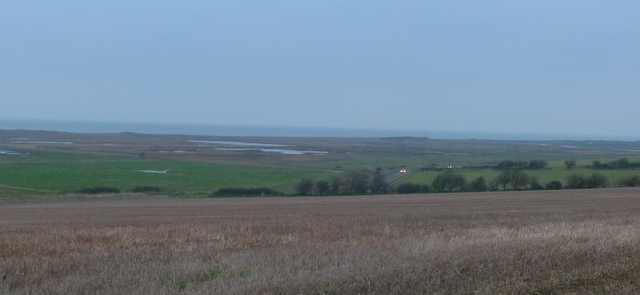 Salthouse – the view over the marshes from Sarbury Hill
Salthouse – the view over the marshes from Sarbury Hill
From the beach, we had not seen any sign of the Brent Geese returning from where they had flown, so we decided to drive back and have a quiet walk up over the paths beyond the coast road to see if we could locate them. A couple of fields up behind the road, we saw through a gap in the hedge that there was a large flock feeding in a winter wheat field. Moving very slowly, we got ourselves into a position where we could see the geese. They could see us too, but by making sure that we didn’t spook them as we approached, they were happy to walk slowly away from us and resumed feeding. A quick scan through the flock revealed the Black Brant – its much darker body plumage, very bold white flank patch and striking, thick, white collar all immediately serving to distinguish it from our usual wintering Dark-bellied Brent Geese. We got great views of it through the scope.
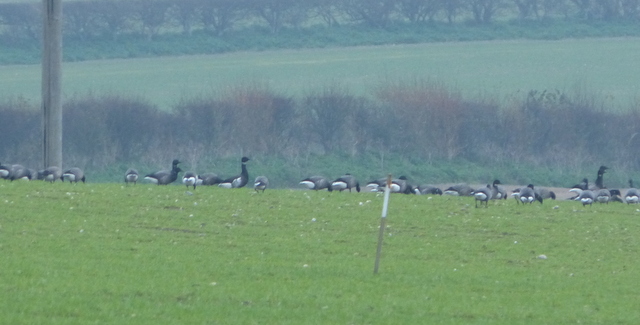 Black Brant – amongst Dark-bellied (& one Pale Bellied) Brent Geese
Black Brant – amongst Dark-bellied (& one Pale Bellied) Brent Geese
A second scan through the flock and we picked up a rather paler bird – this time a Pale-bellied Brent Goose. This race of Brent occurs regularly but rather uncommonly in Norfolk, coming from places such as Greenland, Spitzbergen or Arctic Canada, much further west than our Russian Dark-bellieds, it typically winters in the west of the UK. At one point, as it walked through the flock, we had the three races of Brent Goose all in the scope together! It is not very often that happens. We retreated as the flock walked away from us over the brow of the hill and out of view.
We moved on to the East Bank at Cley. It was not great weather for Bearded Tits – cold, damp and overcast, although at least it wasn’t windy – but we thought we would have a go at seeing them anyway. A small group of Redshank was feeding on the new pools at the start of the bank and three Ruff had tried to hide in amongst them, giving us a great opportunity to study the differences between these similar-sized waders. A Marsh Harrier was quartering the reedbed and a showy Little Egret fed on the Serpentine. We could hear both Reed Bunting and Wren calling as we walked along, then suddenly heard the distinctive ‘ping’ of a Bearded Tit. Waiting patiently, and one flew out and dropped into the reeds not too far from the East Bank. Then a male shuffled up a reed and briefly sat out in full view and we could see a female feeding on the edge of the shorter reeds.
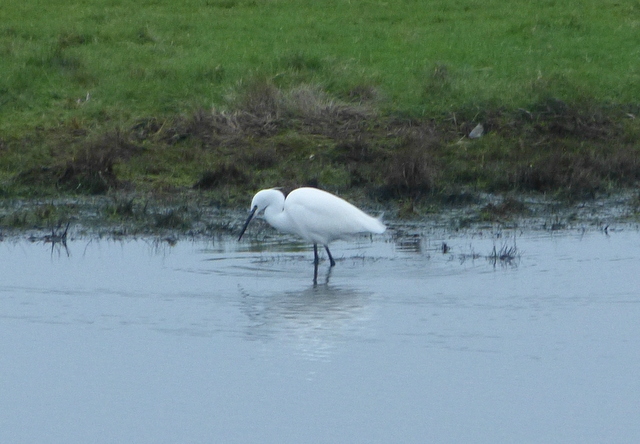 Little Egret – feeding on the Serpentine
Little Egret – feeding on the Serpentine
We headed west to Holkham. Identification of geese was a topic of interest, so we stopped at Lady Anne’s Drive to look at the Pink-footed Geese. There are normally a few birds to be found loafing around in the fields by the road here, and we got excellent views, giving us the chance to compare and contrast with some nearby Greylags and to see the size difference versus the smaller Brents which were mixed in with them.
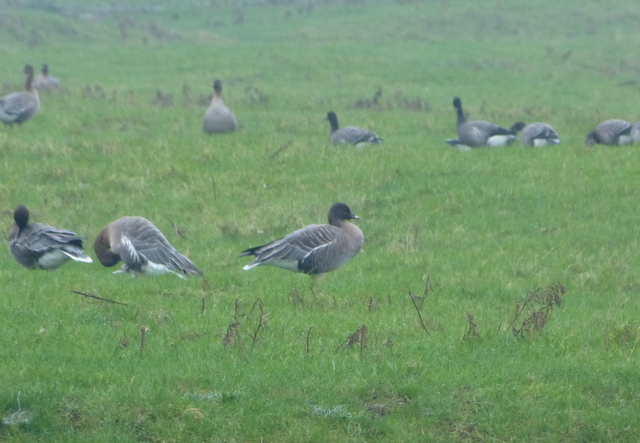 Pink-footed Geese – we had good close up views at Holkham
Pink-footed Geese – we had good close up views at Holkham
By now, the weather had closed in and it was decidedly misty. Undaunted, we carried on towards Burnham Overy and set off to walk out across the marshes to the seawall. The first thing we saw was a group of at least 12 Barnacle Geese out amongst the Brents. The origin of these birds is never entirely clear, as there is a large feral population in the UK these days. A short distance further on and we could hear a cacophony of sound approaching from behind. Gradually, out of the mist, we could see the source approaching – at least 2,000 Pink-footed Geese had been disturbed from the sugar beet fields inland, where they had been feeding, and had decided to flight into the grazing marshes. They came right overhead – a truly amazing sight.
 Pink-footed Geese – at least 2,000 birds came right over our heads
Pink-footed Geese – at least 2,000 birds came right over our heads
There were several small groups of Brents on the grazing marshes as we walked out, and in one of them a bird stood out. Not quite as dark as the Black Brant we saw earlier, the flank patch not quite as white, but still with a very striking collar, this was a hybrid Black Brant x Dark-bellied Brent Goose. This bird has been returning to the same area every winter for many years – unfortunately, not normally as accommodating as it was today, right by the path, just as the weather meant there was not enough light to get what would have been a fantastic set of photographs. Always the way!
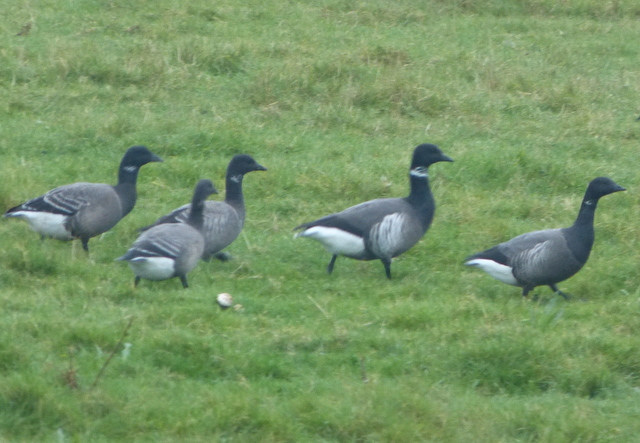 Black Brant x Dark-bellied Brent hybrid – a regular at this site
Black Brant x Dark-bellied Brent hybrid – a regular at this site
From up on the seawall, we could see a good selection of waders out on the mud – Grey Plover, Redshank, Dunlin, Knot and Oystercatcher. Later on, after walking out through the dunes to the beach, we added Sanderling, Turnstone and a fly-by Bar-tailed Godwit to that list. Also by the seawall, we flushed a little covey of three Grey Partridges which flew out and landed on the saltmarsh, where we could get them in the scope.
The first raptor we picked out was a female Marsh Harrier, which sat on a bush in the reeds. We watched it as it flew away and chased off a male nearby. However, the bird we had really come here to see was the Rough-legged Buzzard. Just as it looked like we might be out of luck, we picked up a fence post looking slightly taller than it should at a great distance across the marshes. In the scope, through the mist, we could just about make out a pale head – it was a Rough-legged Buzzard. Walking further up the path didn’t help – it was still a long way off and visibility was very poor. However, it had turned round and we could see its solid dark belly patch. Hardly satisfactory views, but under the circumstances, better than we might have feared. At least we had seen it.
After our walk out to the beach, we headed back along the path. A glance out over the saltmarsh revealed a raptor approaching from the west. As it got nearer, it was clearly a Rough-legged Buzzard. It proceeded to come right overhead, giving us great views of its underparts, and as it flew away from us, it banked to show off its white tail with black terminal bank. Stunning, so close, if only the light had been better and the cameras had been out! We were still not finished and, a little further back along the seawall, some mournful honking alerted us to two Bewick’s Swans flying low overhead and away to the west. Well worth the walk out, despite the weather.
What little light there had been was now fading fast, so we headed back to Lady Anne’s Drive and enjoyed the sight and sound of the thousands of Pink-footed Geese coming in to roost.
















